Samsung Galaxy Note 8 vs Apple iPhone 7 Plus

Introduction
The flames have been extinguished. The ashes of the past – forgotten. Mistakes – forgiven.
A new Galaxy Note is here. And boy is it a beast. Hungry. Raw. Yet, deep inside, you can see it’s also gentle, humble. It’s the kind of beast you don’t want to mess with.
But then, there’s another one. Older, charismatic, proven – this one, you don’t even compete with; it’s there to inspire you, show you the way. It’s the iPhone 7 Plus.
And yet, here we are in the company of these plus-sized beasts, and it’s obvious this is quickly going to get messy. Also, beautiful! Because what we have here is nothing less than two of the finest personal computing devices ever made. Ladies and gentlemen, this is the comparison you’ve been waiting for: Samsung Galaxy Note 8 vs Apple iPhone 7 Plus!
Design
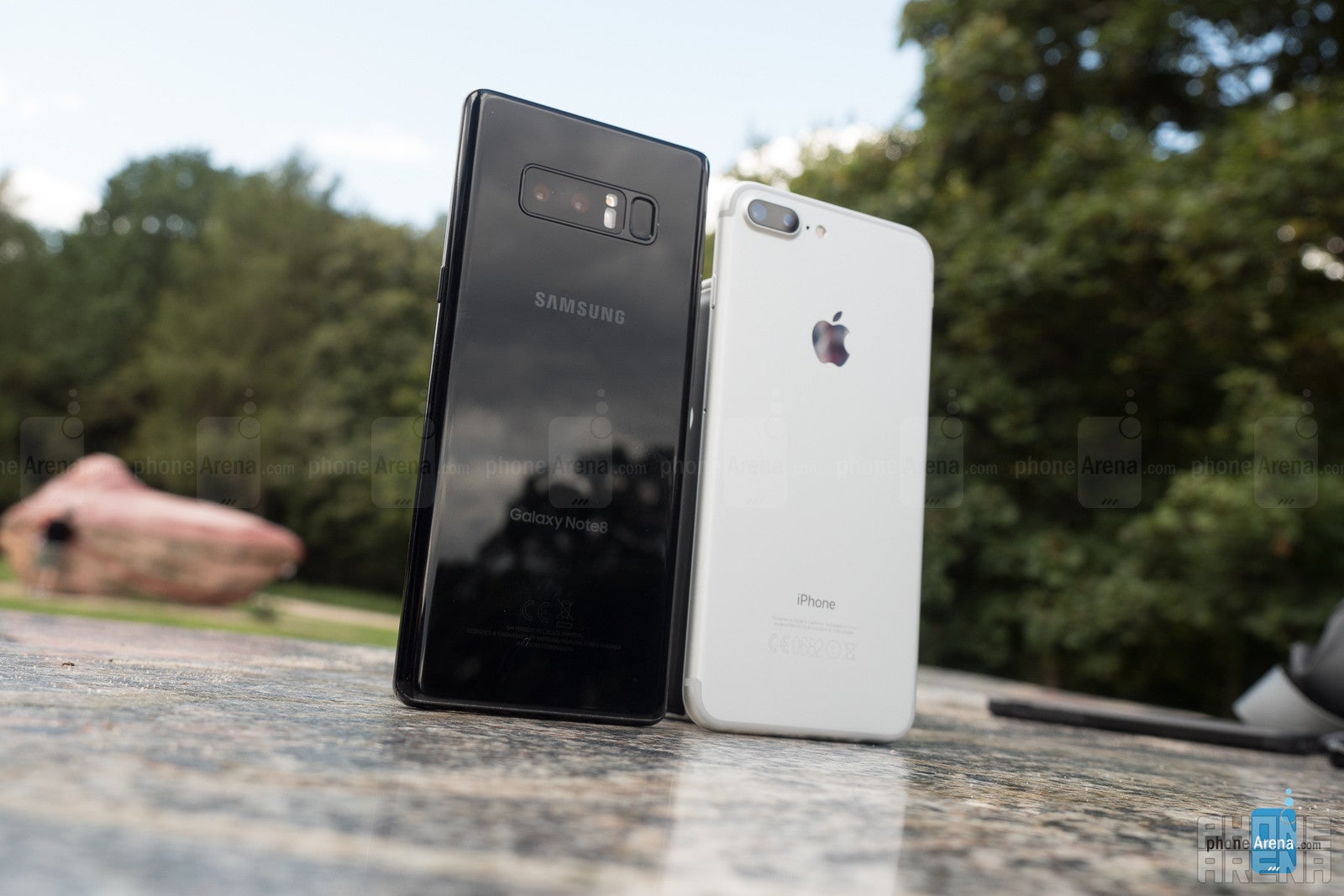
Samsung and Apple have different approaches when it comes to exterior design. Samsung prefers iterative, year-to-year updates, while Apple usually comes up with a forward-looking design which it then uses for at least a couple of years. Right now, Apple's iPhone 6 / 6s / 7 design is obviously close to running its course, which puts it at a disadvantage against Samsung's current Note 8 styling, for a couple of reasons:
1) Samsung has significantly reduced the bezels around the screen, and in the case of the Note 8, things are pretty symmetrical, so it looks great. Apple's iPhone 7 Plus, on the other hand, doesn't utilize frontal space too efficiently, by today's standards, keeping considerable top and bottom bezels, making the device larger than it needs to be. It still looks very nice, but is something that's going to be addressed in the next iteration of the iPhone. Not only do thinner bezels look more modern, they also mean the manufacturer can choose to fit a larger display in the same space, which is exactly what we have in this case, with the Note 8 having a significantly taller panel, allowing for more content to be shown at a time.
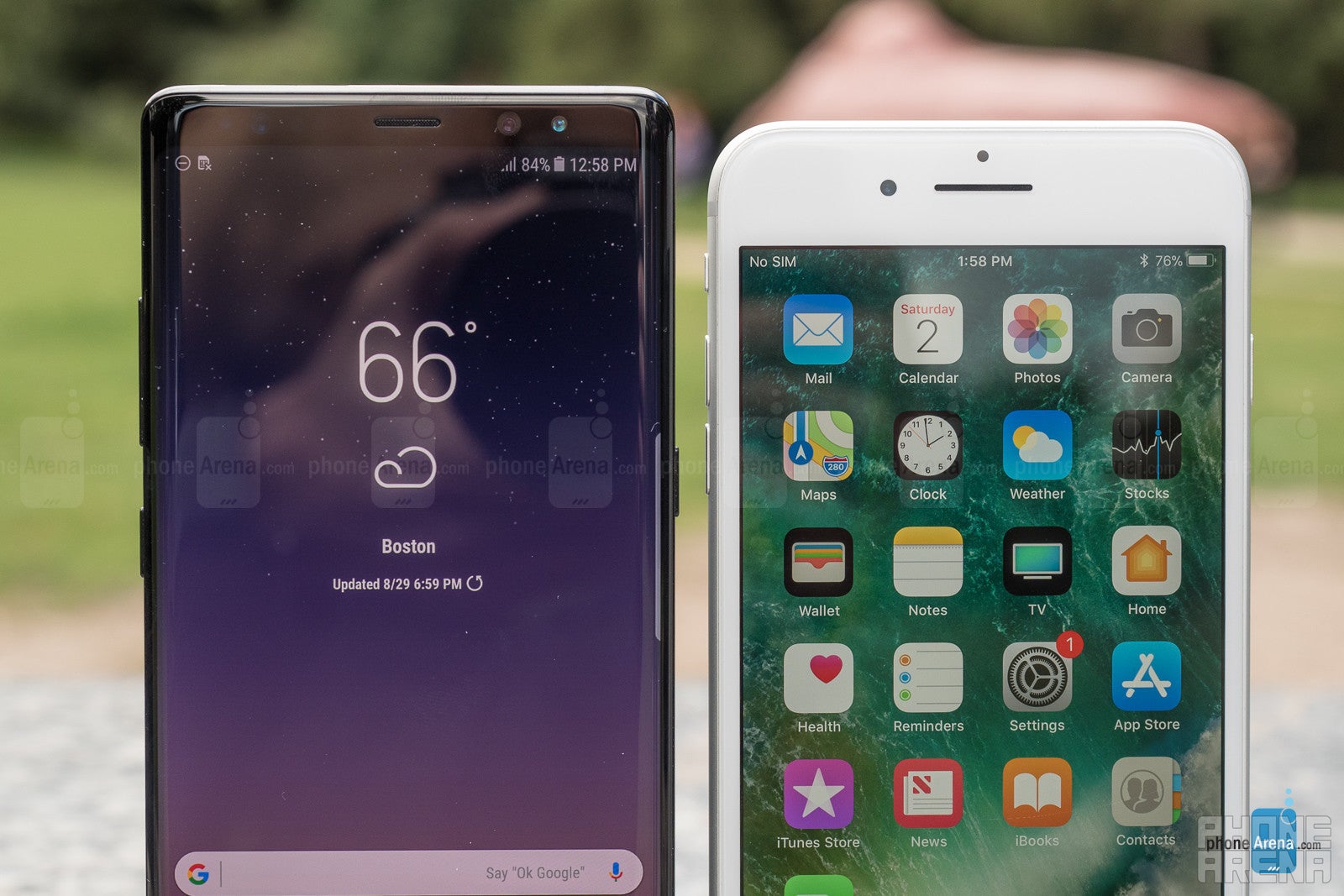
Both the Galaxy Note 8 and iPhone 7 Plus are certified as water- and dust-resistant, with IP68 rating for the Note 8 and IP67 for the iPhone 7 Plus. The actual difference in these certifications isn't considerable. It's great to have the confidence that both handsets should easily survive a spill of a drink (or a few!) on them. Beautiful and tough – these guys seem to have conquered all frontiers!
Display
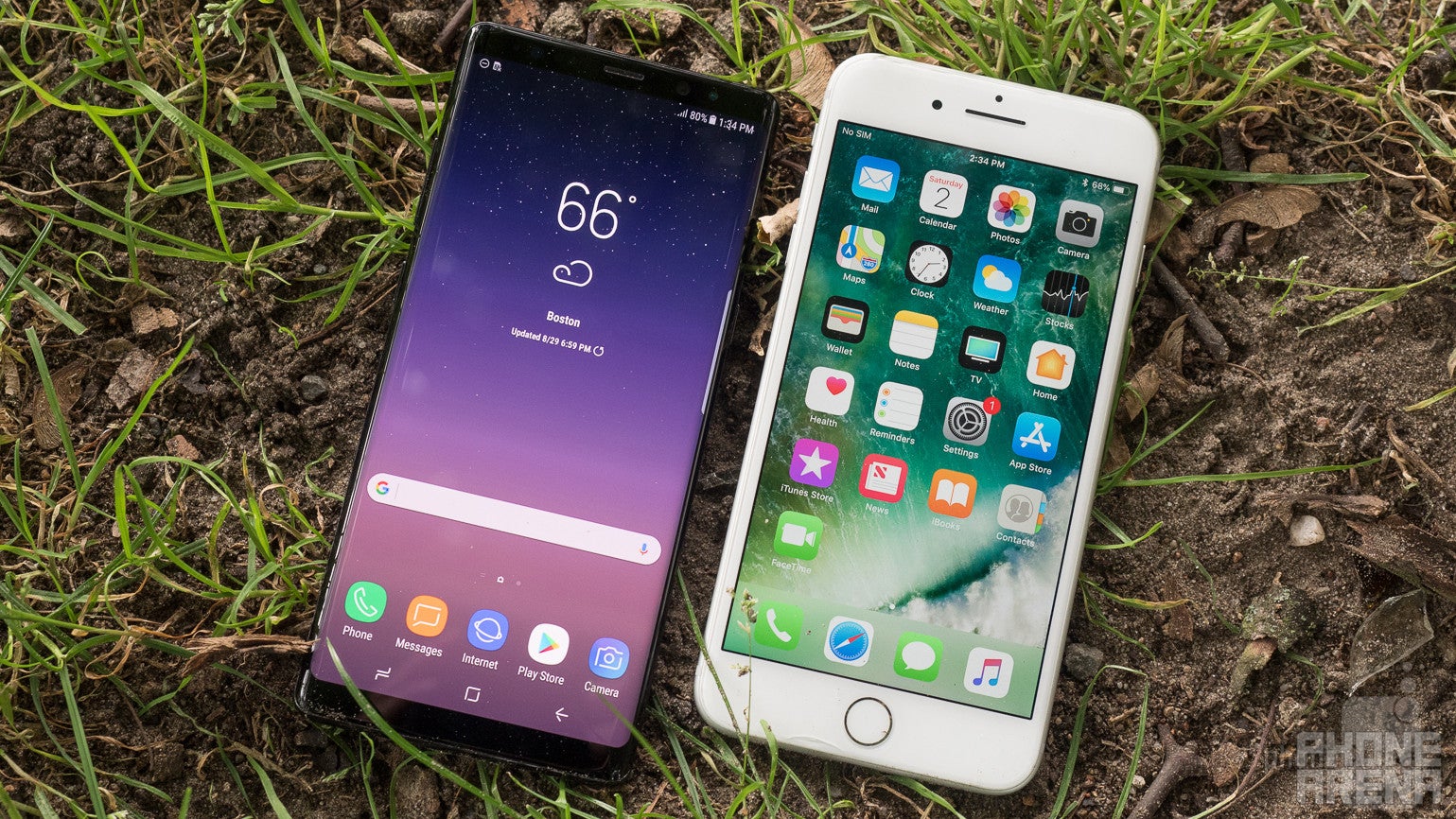
At 6.3” and 9:18.5 aspect ratio, the Note 8’s AMOLED display stands tall like the Burj Khalifa. Fun fact: Samsung’s engineering and construction division was among the main contractors who built Burj Khalifa. But let’s get back to the phones.
The iPhone 7 Plus has a comparably massive 5.5” 9:16 LCD display. The main difference is that the Note’s one is taller, allowing for more content to be displayed vertically. The great thing about the Note here is that it manages to fit this expansive screen in a body of similar size to that of the iPhone 7 Plus. The Note 8 also features a higher screen resolution, but it’s mostly overkill, and even Samsung has chosen 1080px resolution to be the default one – same as what you get on the iPhone 7 Plus.
Color balance is great with both smartphones. The Galaxy Note 8 can be either unnaturally vibrant, or very precise, depending on the screen color mode that you choose. The iPhone 7 Plus also has a fantastic screen; perhaps a tad colder than needed, but still lively and accurate. Compared to the Note 8’s OLED technology, the 7 Plus’ LCD doesn’t appear quite as vivid, but it does retain its color accuracy way better when viewed at an angle.
Interface and Functionality
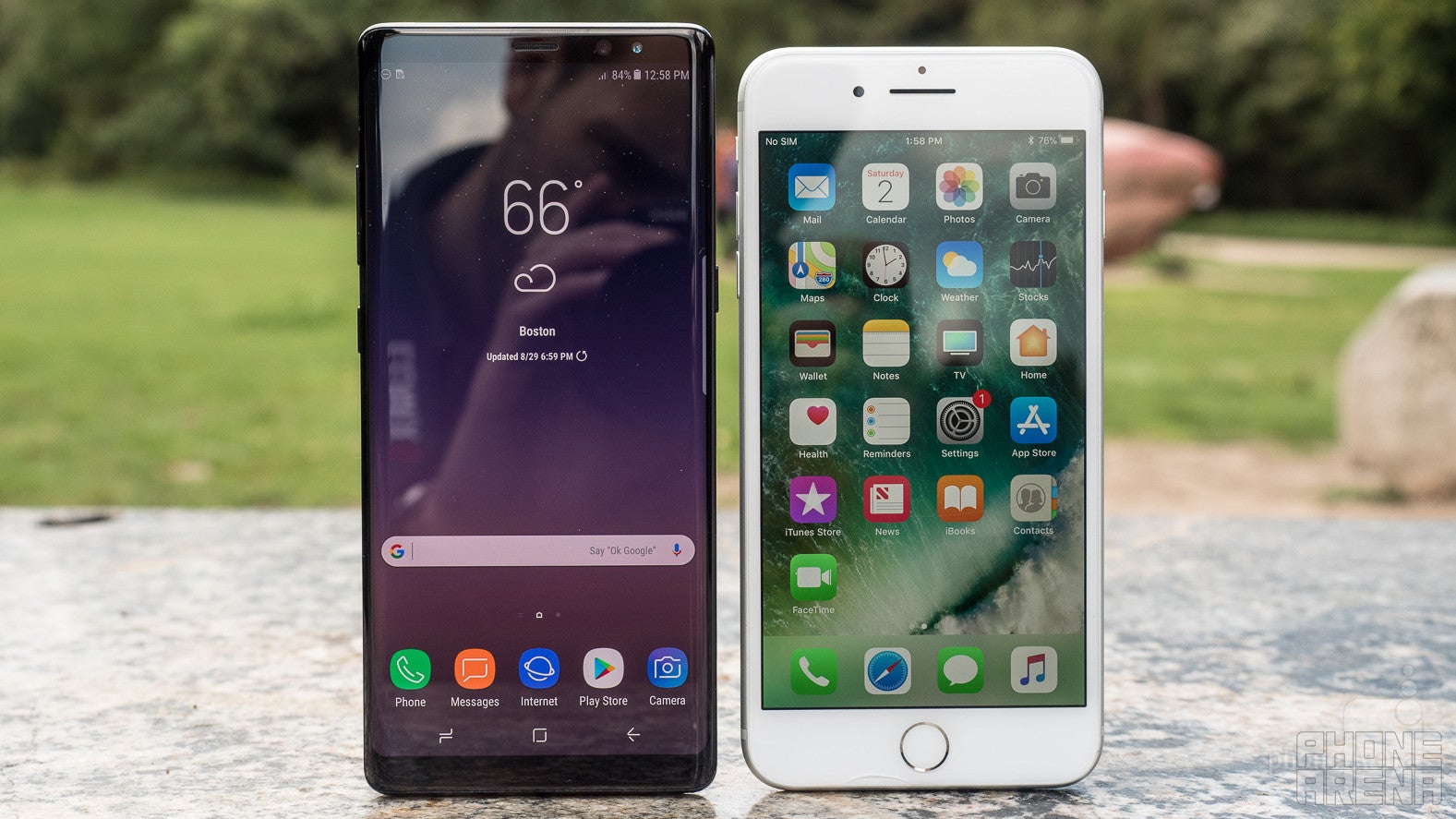
The Galaxy Note 8 launches with Android 7.1, and we imagine it’ll be getting an update to Android 8 soon after. Meanwhile, the iPhone 7 Plus is running iOS 10, with an update to iOS 11 expected to drop in a couple of weeks.
At this point, both platforms can be considered very mature. The more interesting story is the Samsung Experience user interface, which the company reinvented yet again with the introduction of the Galaxy S8 series. This is clearly the best version of Samsung’s UI yet, with a consistent and unique new visual design. With the Note 8, Samsung turns up the eye candy even more, with a beautiful new lockscreen animation. The software is relatively intuitive to navigate and use, though some of its more advanced features need some getting used to: like setting up pre-defined app pairs for dual-window multitasking, for example.
And this brings us to the Galaxy Note 8's main area of expertise, which is productivity. Right from the start, the Note 8 is a comfortable machine to work on, due to the sheer size of the display. Its tall aspect ratio, however, also makes it suitable for dual-app multitasking, where you can view two apps side by side at the same time. Samsung has also enabled drag-and-drop functionality across some apps, like Files and Internet, for example, to further cement the Note's status as a smartphone to get work done with. Of course, the S Pen is a big asset here, allowing you to easily take notes, or interact with web sites and content in a variety of empowering ways.
So how does iOS 10 compare? Well, Apple has also been doing an awesome job over the years at keeping iOS relevant and improving it in meaningful ways. Nowadays, iOS 10 offers a modern visual design and sticks with the same "even your mom can use it" principles. Unlike the Note 8, its built-in productivity features and the S Pen, however, Apple's iOS 10 brings the consumer's apps to the forefront. The powerful and refined app ecosystem is backed up by the versatile and reliable first-party software that comes with iOS 10. What's more, Apple's own iWork and iLife suites are incredibly capable additions which can greatly expand the range of what you can do on your iPhone, from music creation with GarageBand to 4K video editing with iMovie. In terms of file management, you need to install third-party software right now, but iOS 11 will introduce Apple's own Files application.
Performance and Memory
Hardware and performance are cutting edge on the Galaxy Note 8 and iPhone 7 Plus. Of the two, the iPhone 7 Plus has more immediacy and responsiveness, although the difference isn’t too noticeable. Even though the 7 Plus’ A10 chipset is now a year old, it’s still more than powerful enough to provide all the horsepower you may need, be it for gaming, productivity, or social networking.
The Note 8’s Snapdragon 835 (or Exynos 8895 if international) is the best chipset Qualcomm has to offer at the moment. Performance is generally smooth, although occasional lag is to be expected in the long term, when you have it loaded up with apps, accounts, media, and what not.
There isn’t much flexibility in terms of internal memory on the Note 8, as it only comes with 64 GB, but it does offer a microSD card slot, so you can still expand the available storage space, at least for documents and media. The iPhone 7 Plus, on the other hand, does not allow memory expansion, but you can purchase it with 32, 128, or 256 GB of internal memory.
Internet and Connectivity
Browsing is great with both phones. Some websites’ content may appear to close to the Note 8’s curved screen edge, making for a somewhat weird to look at, but it’s not too much of a pain. Samsung’s own Internet browser is a great alternative to Chrome, which is an impressive achievement: few companies have the capacity to build truly capable web browsers these days.
Speaking of which, Safari on the iPhone 7 Plus remains an incredibly refined and speedy browser, which makes the surfing experience a joy. The 7 Plus has a massive display for comfortable viewing, but the Note 8 pushes that even further with an extra-tall screen, which happens to be especially suited for viewing web pages.
In the connectivity department, the Galaxy Note 8 takes advantage of the newer Bluetooth 5 protocol for enhanced range and bandwidth, but to enjoy the benefits, you also need to pair it with other Bluetooth 5-enabled accessories. Aside from that, both phones will be available on pretty much every carrier, so networking and coverage should be a non-issue.
Camera
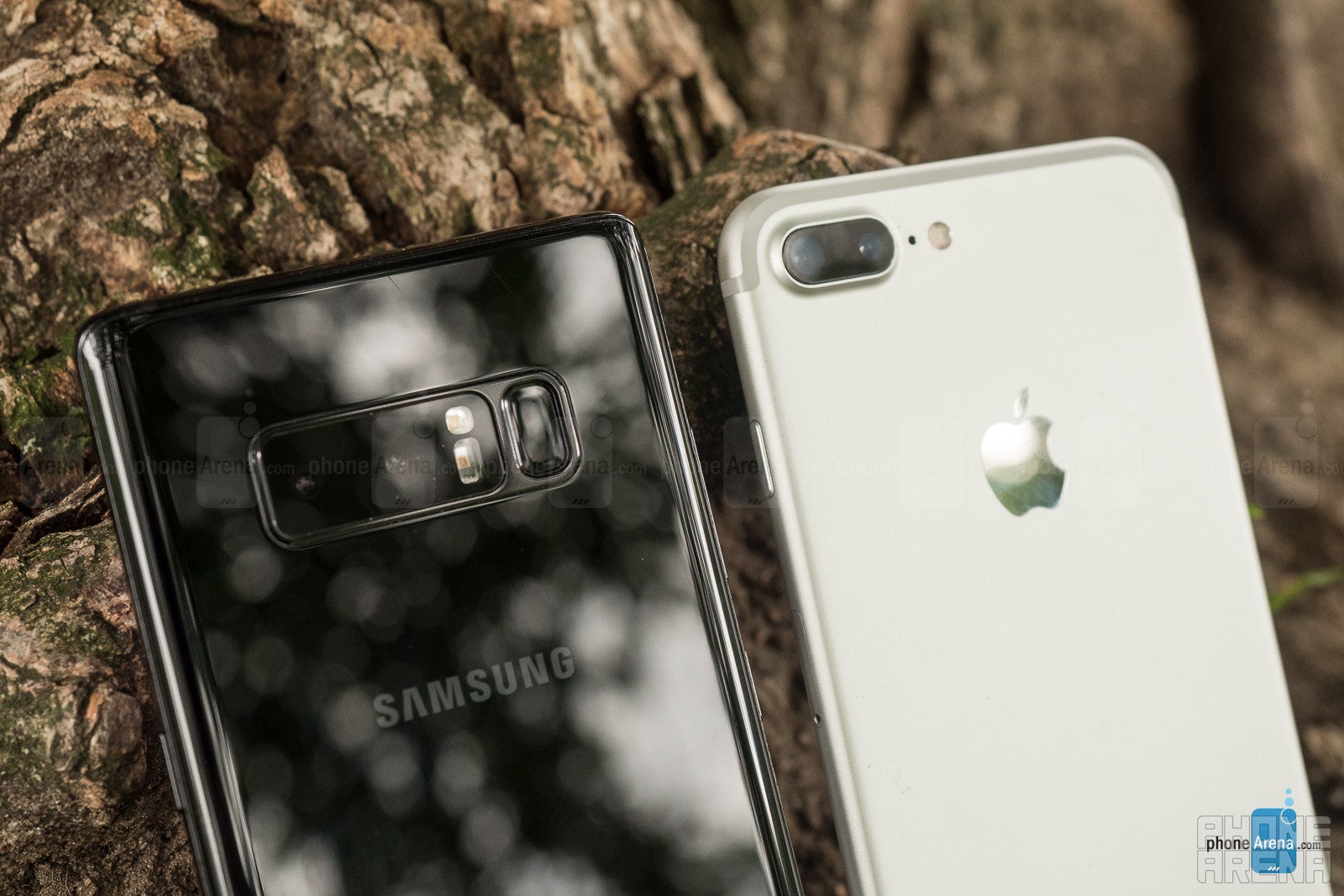
Users have been enjoying the benefits of the dual-camera system Apple has installed on the iPhone 7 Plus for a while now, getting acquainted with how to use features like Portrait mode and optical 2x zoom. Now, for the first time with the Note 8, Samsung is joining the dual-shooter party as well. Generally, what Samsung does here is pretty similar to Apple's implementation, 2x zoom and portraits included.
There is one major difference, and that's the ability to change the focus point in a picture after the fact with the Note 8. You can do this from the Gallery app. You can also adjust the amount of background blur (bokeh) effect that you want, if you're working on a portrait shot.
Image quality
Image quality dynamics don't change much with this new edition of the Note. Samsung's first-ever dual-camera remains true to what we've come to expect from the S8's 12MP camera, and that's mostly a good thing. Between the Note 8 and iPhone 7 Plus, we're looking at very similar results in that both cameras capture superb photographs.
There are two main differences between them: 1) the Galaxy Note 8 manages to capture slightly more detail; and 2) the iPhone 7 Plus shoots pictures with more realistic color tones. That's pretty much it.
You can't go wrong with any of these two cameras. It's surprising though just how much the Note 8 tries to capture a scene and then sprinkle it with some magic dust in order to make it looks better than it actually was. We'd rather stick with the more natural-looking processing of the iPhone 7 Plus. Nevertheless, the Note 8 tends to remain slightly more composed in super-dark scenarios, where photos from the 7 Plus start to look decolorized, but those are mostly extreme cases.
With the Galaxy Note 8 now featuring a secondary, telephoto camera, it can now capture good-looking portraitsa with simulated bokeh (blurred background) effect. We really enjoy snapping portraits with both the Note 8 and the 7 Plus. Results seem almost identical most of the time, with both handsets experiencing very similar issues when generating the bokeh effects. You have the option to adjust the bokeh intensity on the Note 8, which is a convenient option to have – some scenes may look better with more/less background blur than what the default setting presents.
Video quality
The Note 8 marks another step forward for the video recording capabilities of Samsung's Galaxy smartphones. The improvements we notice here over the Galaxy S8 line are found in 1) more stabalized footage – very little seems to be left of the annoying jello effect, of which the S8 suffers greatly; and 2) the microphone captures better, clearer sound. In short, the Note 8 is an awesome 4K video recorder, plus you can now do 2x optical zoom.
In comparison with the iPhone 7 Plus, the Note 8's footage looks very similar, although slightly sharpened. That becomes more apparent if you zoom in 2x, and even more if you go further digitally, say to around 5x-6x zoom. There, the iPhone's footage continues to look relatively clear, while the Note's gets very noisy. The iPhone 7 Plus also captures the more stable, artifact-free video, with no jello and less focus hunting. The latter may be a result of the Note 8 trying too hard to immediately adjust its focus, thus it's more likely to experience unneeded focus shifts. Meanwhile, the 7 Plus takes more time to determine whether the change in the scene really warrants a change in focus, and if yes, then proceeds to do so with a slower, smoother transition.
One area where we do prefer the Note 8's footage is sound, and more specifically, the sound properties of the operator's voice. With the Note 8, if the person recording the video speaks or narrates, their voice sounds very nice and clear. Unfortunately, this isn't the case with the iPhone 7 Plus, where the voice of the person holding the phone sounds rather muffled.


Multimedia
You can get a slightly bigger image with the Note 8 when watching video, but the extra-wide 18.5:9 aspect ratio means it's not that much bigger than the iPhone 7 Plus' 16:9 screen. Most video content fits the iPhone 7 Plus' screen better, as it's been shot in 16:9, but there are music videos out there shot in extra-wide aspect ratio as well, and those tend to display better on the Note 8. Set at FHD resolution by default, the Note 8 doesn't necessarily take advantage of its higher display resolution, and indeed, even if you manually max it out from the settings, the visual benefit would be minimal.

Sound-wise, the iPhone 7 Plus' stereo speakers sound great (for a phone), with good clarity and decent depth. The Note 8's bottom-facing loudspeaker is also quite strong, and gets the job done effectively.
Music listening is effortless with both handsets nowadays, as both Google Play Music and Apple Music are available on both iOS and Android, so no matter the platform, you'll always have access to your own music library. Same with Spotify. Samsung bundles AKG-branded in-ear headphones with the Note 8, and they sound alright for the most part. The iPhone 7 Plus' EarPods, though, excel in comfort and ease of use. They work through the Lighting connector (there is no 3.5mm jack on the iPhone, unlike on the Note), but Apple bundles a Lighting to 3.5mm adapter in the box, so if you have a preffered wired set of earphones (that are not the EarPods), you'll be able to use them without too much hassle.
Call quality
We didn’t experience any issues worth reporting while having calls with either smartphone. The iPhone 7 Plus tended to be loud and clear, while the Samsung Galaxy Note 8 was just fine. We noticed the tall form factor worked well for phone calls.
Battery life
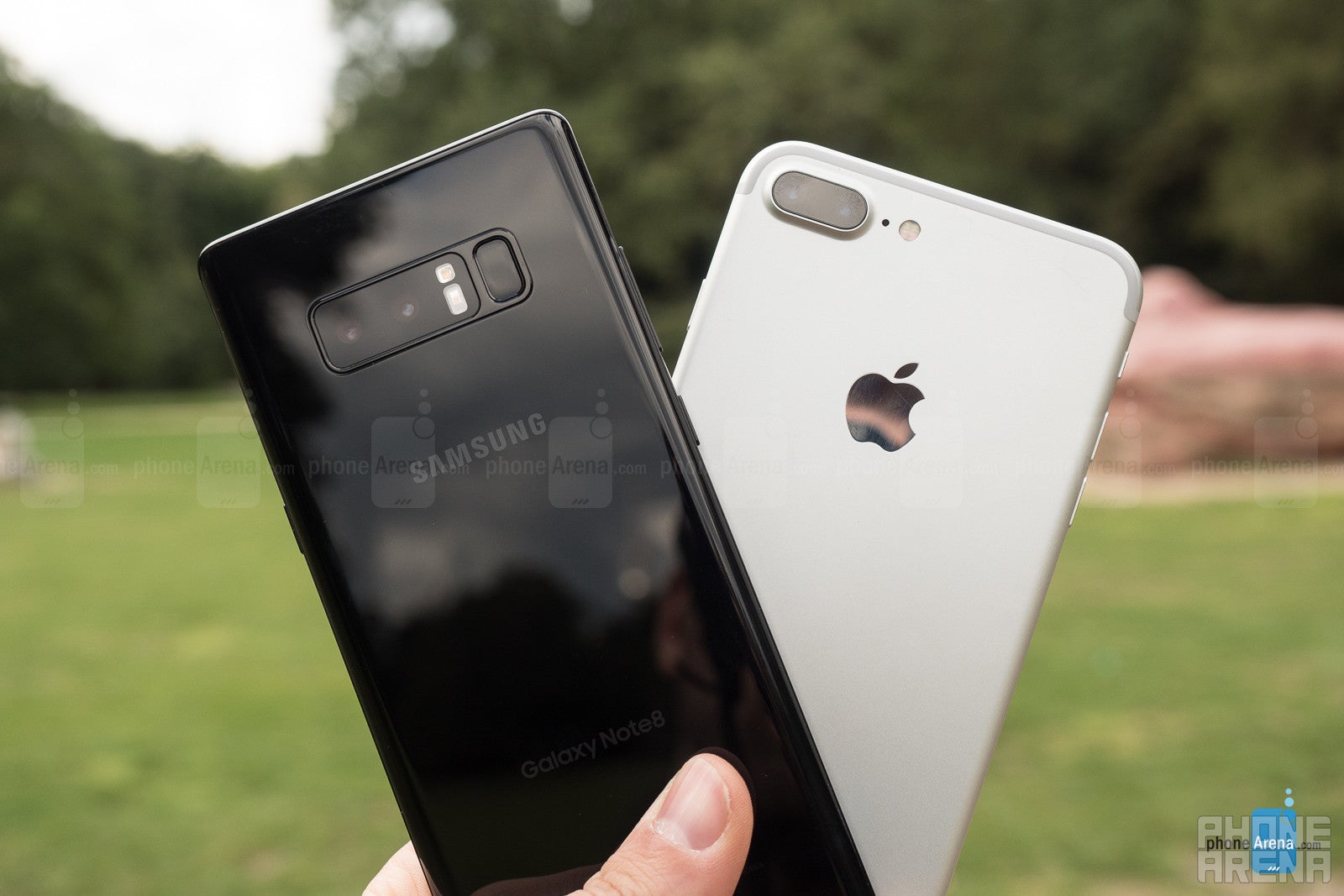
Ah, here’s the interesting part, eh? So Samsung decided to play it safe with the Note 8, that much is obvious. It gave it a smaller battery than before, and it also made the phone bigger than its predecessor – all measures that would ensure last year’s disaster won’t happen again. But with the smaller capacity, fans of the series are now understandably nervous, wondering whether the 3300 mAh capacity would be enough to power this extremely decked out handset for a long enough period. Well, let’s see!
We’ve run both the Note 8 and iPhone 7 Plus through our special battery benchmark, and here are the results we got:
- Galaxy Note 8: 7 hours 50 minutes
- iPhone 7 Plus: 9 hours 5 minutes
Now, what do these results mean? First off, they mean the iPhone 7 Plus offers superb battery life that can easily stretch up to two days with moderate usage, and that’s despite its smaller, 2900 mAh battery. As for the Galaxy Note 8, its result is by no means bad, but it means that you’ll hardly get much more than a full day. With modest use, you might be able to get into the second day, but the juice levels will be so low, you’ll still more than likely need to charge in the morning. The reason why the iPhone 7 Plus can extend its running time on a single charge so considerably is partly thanks to its lower consumption while on stand-by.
Conclusion
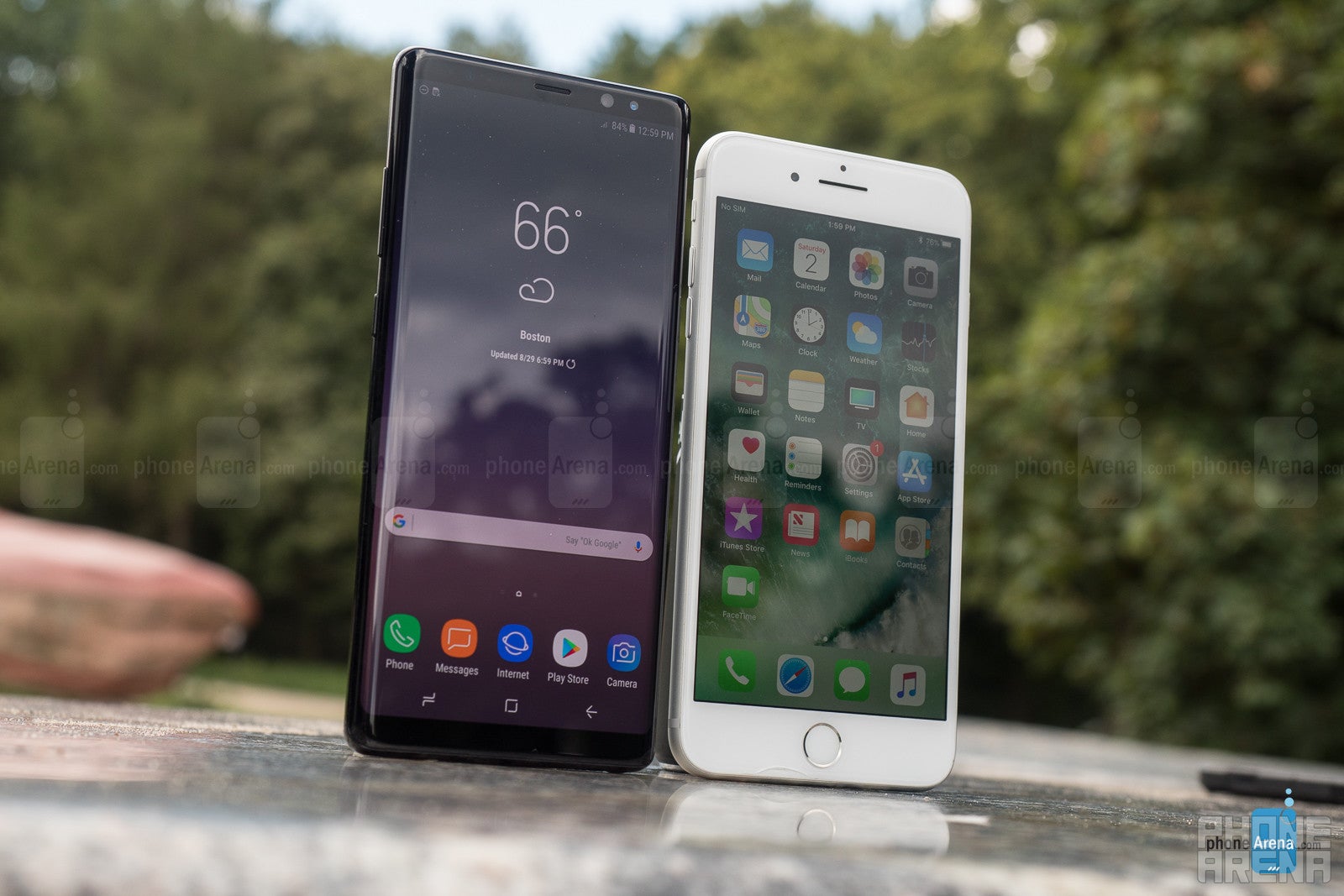
Between the Galaxy Note 8 and the iPhone 7 Plus, it's the Note 8 that currently has the 'wow!' advantage. This is exclusively due to its modern, almost-bezelless design, as well as smooth, glossy finishes and fresh color options. When you pick up a Note 8, even the boring all-black one, it strikes you as an intensely powerful and cutting-edge device; an extremely expensive, $930 high-end smarpthone that can do it all, and then some. And it really delivers. Right now, it's the culmination of Samsung's expertise and effort in mobile. This is the ultimate Galaxy.
Apple's current design language has aged rather gracefully. It's currently at the end of its third year, and yet it still looks precise, classy and stylish. However, it's aged nonetheless. The thick frame surrounding the screen is a big problem on the big-screen iPhone 7 Plus, much more so than on the smaller iPhone 7. It's a limiting factor. Yet, even a year after its debut, the 7 Plus has remained powerful and capable enough so it can easily go up against the Note 8, and occasionally best it in some areas.
Determining a “better” phone in this comparison would be impossible, because both handsets manage to hold their own grounds. Neither would budge. It's impressive how capable and polished both platforms have become: iOS, and the Android-based Samsung Experience. Now, more than ever, we have two big-screen flagships that are equally magnificent.
Samsung Galaxy Note 8
Pros
- Modern, striking look with thin bezels
- Impressively versatile and capable
- S Pen drawing instrument
Apple iPhone 7 Plus
Pros
- Superb apps & software support
- Better system coherence and performance
- More affordable price
Follow us on Google News

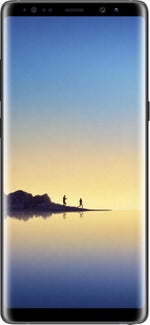















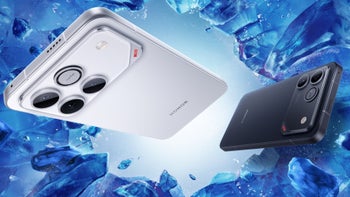





Things that are NOT allowed:
To help keep our community safe and free from spam, we apply temporary limits to newly created accounts: